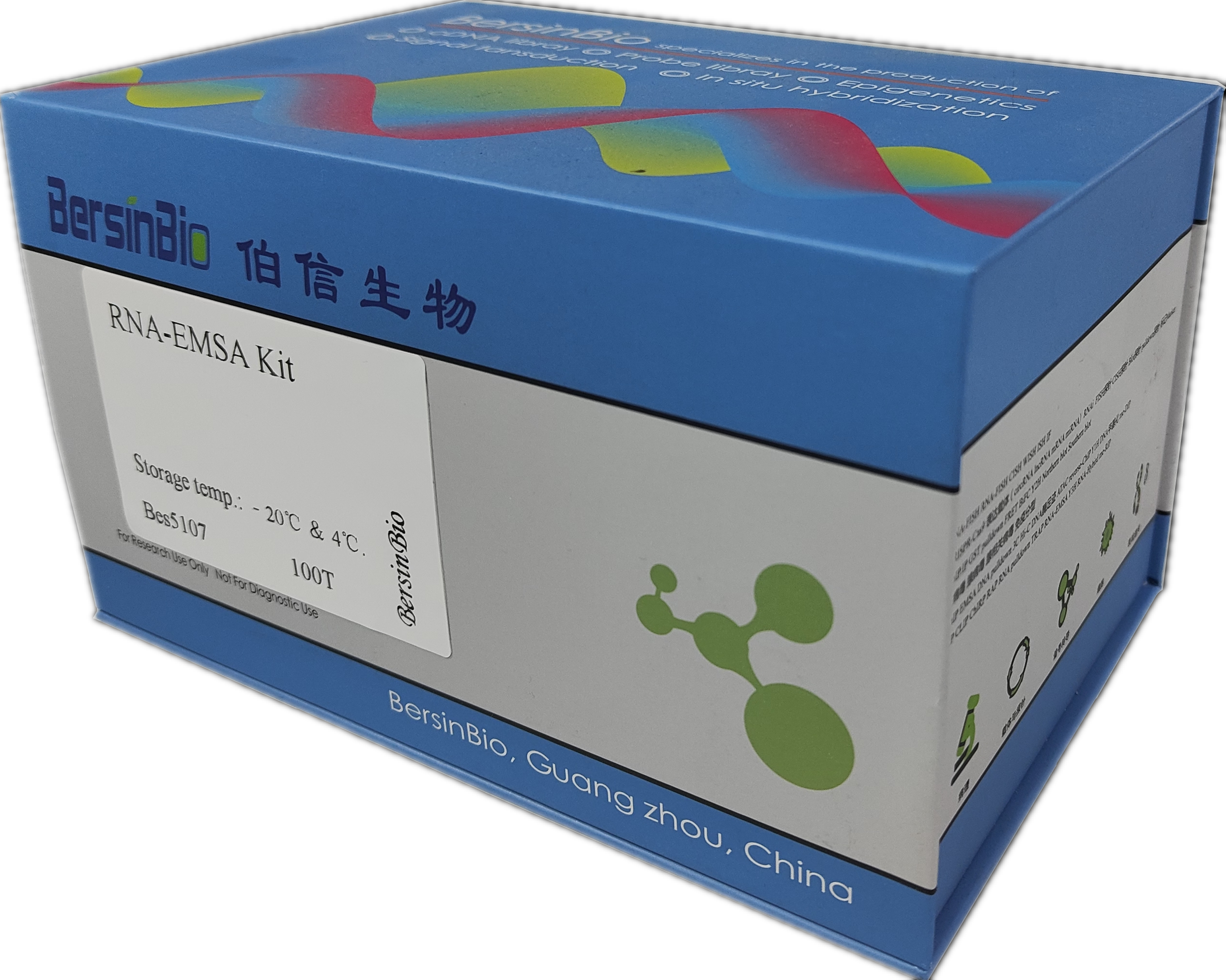Product introduction:
EMSA is a classic method for studying specific nucleic acid binding proteins, and is a technique for qualitative and quantitative analysis of nucleic acid-protein interactions.This method is not only simple, rapid and highly sensitive; on the other hand, it can be used to evaluate the properties of protein and nucleic acid binding by using a competition test.It is currently used to detect RNA-binding proteins, and can be used to detect specific proteins by adding specific antibodies. The binding protein two-dimensional electrophoresis and mass spectrometry techniques can be used for identification and analysis of unknown proteins.(This kit is for scientific research purposes only)
A specific probe is designed for the target area and labeled with biotin.The end-labeled nucleic acid probe can bind to the protein. During electrophoresis, the probe and the protein complex move slowly in the gel, that is, it shows a relative lag.

Technical process:

Product features:
1.Safety and environmental protection: The non-isotopic chemiluminescence detection system is adopted to avoid the danger of radioactivity and the trouble of handling isotope waste, and reduce environmental pollution; no special isotope operation room is required, and it is easy to use and promote.
2.High sensitivity: The detection sensitivity is high, which is equal to or exceeds the isotope labeling system, and the detection result background is lower.
3.Fast and time-saving: From labeling probes to result analysis, all experiments only take 5 hours.
4.Stable and reliable: The RNA ends are labeled with biotin, which does not affect the protein binding site; the labeled RNA can be stored for one year.
5.Equipped with complete equipment: equipped with BersinbioTM cell nucleus extraction kit.
6.Personalized service: personalized high-sensitivity probes can be customized according to research needs.
Instructions
Bes5003 DNA-EMSA
Bes5107 RNA-EMSA
Articles
【In 2023】
Article:The RNA-binding protein hnRNP F is required for the germinal center B cell response
Periodicals:Nature Communications
IF:16.600
Article:An inducible long noncoding RNA, LncZFHX2, facilitates DNA repair to mediate osteoarthritis pathology
Periodicals:Redox Biology
IF:11.4
Article:OsCCRL1 is Essential for Phenylpropanoid Metabolism in Rice Anthers
Periodicals:Rice
IF:5.500
【In 2022】
Article:ENKUR expression induced by chemically synthesized cinobufotalin suppresses malignant activities of hepatocellular carcinoma by modulating β-catenin/c-Jun/MYH9/USP7/c-Myc axis
Periodicals:International Journal of Biological Sciences
IF:9.200
Article:GcvB Regulon Revealed by Transcriptomic and Proteomic Analysis in Vibrio alginolyticus
Periodicals:International Journal of Molecular Sciences
IF:5.600
【In 2021】
Article:Global identification of full‐length cassava lncRNAs unveils the role of cold‐responsive intergenic lncRNA 1 in cold stress response
Periodicals:Plant Cell Environ
IF:7.300
Article:VPS33B suppresses lung adenocarcinoma metastasis and chemoresistance to cisplatin
Periodicals:Genes & Diseases
IF:7.103
Article:miR-1254 induced by NESG1 inactivates HDGF/DDX5-stimulated nuclear translocation of b-catenin and suppresses NPC metastasis
Periodicals:Molecular Therapy: Methods & Clinical Development
IF:6.698
Article:An insertion variant of MGMT disrupts a STAT1 binding site and confers susceptibility to glioma
Periodicals:Cancer Cell International
IF:5.722
Article:A direct negative feedback loop of miR-4721/FOXA1/Nanog promotes nasopharyngeal cell stem cell enrichment and metastasis
Periodicals:Journal of Translational Medicine
IF:5.531
Article:VPS33B interacts with NESG1 to suppress cell growth and cisplatin chemoresistance in ovarian cancer
Periodicals:Cancer Science
IF:4.965
【In 2020】
Article:Silencing MYH9 blocks HBx-induced GSK3β ubiquitination and degradation to inhibit tumor stemness in hepatocellular carcinoma
Periodicals:Signal Transduction and Targeted Therapy
IF:13.493
Article:MicroRNA-3613-5p Promotes Lung Adenocarcinoma Cell Proliferation through a RELA and AKT/MAPK Positive Feedback Loop
Periodicals:Molecular Therapy: Nucleic Acids
IF:8.889
Article:circRNA Hipk3 Induces Cardiac Regeneration after Myocardial Infarction in Mice by Binding to Notch1 and miR-133a
Periodicals:Molecular Therapy: Nucleic Acids
IF:8.889
Article:miR-4721, Induced by EBV-miR-BART22, Targets GSK3b to Enhance the Tumorigenic Capacity of NPC through the WNT/b-catenin Pathway
Periodicals:Molecular Therapy: Nucleic Acids
IF:8.886
Article:MicroRNA-4476 promotes glioma progression through a miR-4476/APC/β-catenin/c-Jun positive feedback loop
Periodicals:Cell Death & Disease
IF:8.469
Article:MiR-4310 induced by SP1 targets PTEN to promote glioma progression
Periodicals:Cancer Cell International
IF:4.178
【In 2019】
Article:Excessive miR-25-3p maturation via N6-methyladenosine stimulated by cigarette smoke promotes pancreatic cancer progression
Periodicals:NATURE COMMUNICATIONS
IF:12.123
Article:Timeless-Stimulated miR-5188-FOXO1/b-Cateninc-Jun Feedback Loop Promotes Stemness via Ubiquitination of b-Catenin in Breast Cancer
Periodicals:Molecular Therapy
IF:11.455
Article:HBX-induced miR-5188 impairs FOXO1 to stimulate β-catenin nuclear translocation and promotes tumor stemness in hepatocellular carcinoma
Periodicals:Theranostics
IF:8.698
Article:VPS33B interacts with NESG1 to modulate EGFR/PI3K/AKT/c-Myc/P53/miR-133a-3p signaling and induce 5-fluorouracil sensitivity in nasopharyngeal carcinoma
Periodicals:Cell Death & Disease
IF:8.469
Article:Cinobufotalin powerfully reversed EBV-miR-BART22-induced cisplatin resistance via stimulating MAP2K4 to antagonize non-muscle myosin heavy chain IIA/glycogen synthase 3β/β-catenin signaling pathway
Periodicals:EBioMedicine
IF:5.736
Article:Genetic Predisposition to Glioma Mediated by a MAPKAP1 Enhancer Variant
Periodicals:Cellular and Molecular Neurobiology
IF:3.606
【In 2016】
Article:miR-3188 regulates nasopharyngeal carcinoma proliferation and chemosensitivity through a FOXO1-modulated positive feedback loop with mTOR–p-PI3K/AKT-c-JUN
Periodicals:NATURE COMMUNICATIONS
IF:14.92